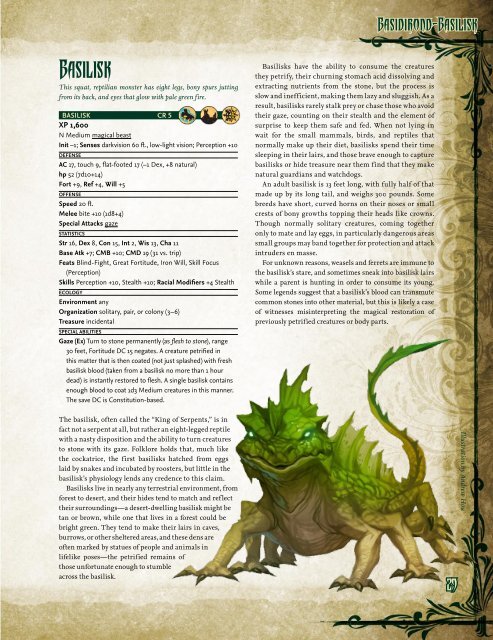Pathfinder - Bestiary 1.pdf - Dorks and Dragons!
Pathfinder - Bestiary 1.pdf - Dorks and Dragons!
Pathfinder - Bestiary 1.pdf - Dorks and Dragons!
Create successful ePaper yourself
Turn your PDF publications into a flip-book with our unique Google optimized e-Paper software.
514653<br />
761681<br />
761681<br />
Basilisk<br />
This squat, reptilian monster has eight legs, bony spurs jutting<br />
from its back, <strong>and</strong> eyes that glow with pale green fire.<br />
BASILISk CR 5<br />
XP 1,600<br />
N Medium magical beast<br />
Init –1; Senses darkvision 60 ft., low-light vision; Perception +10<br />
DEfEnSE<br />
AC 17, touch 9, flat-footed 17 (–1 Dex, +8 natural)<br />
hp 52 (7d10+14)<br />
fort +9, Ref +4, Will +5<br />
OffEnSE<br />
Speed 20 ft.<br />
Melee bite +10 (1d8+4)<br />
Special Attacks gaze<br />
STATISTICS<br />
Str 16, Dex 8, Con 15, Int 2, Wis 13, Cha 11<br />
Base Atk +7; CMB +10; CMD 19 (31 vs. trip)<br />
feats Blind-Fight, Great Fortitude, Iron Will, Skill Focus<br />
(Perception)<br />
Skills Perception +10, Stealth +10; Racial Modifiers +4 Stealth<br />
ECOLOgy<br />
Environment any<br />
Organization solitary, pair, or colony (3–6)<br />
Treasure incidental<br />
SPECIAL ABILITIES<br />
gaze (Ex) Turn to stone permanently (as flesh to stone), range<br />
30 feet, Fortitude DC 15 negates. A creature petrified in<br />
this matter that is then coated (not just splashed) with fresh<br />
basilisk blood (taken from a basilisk no more than 1 hour<br />
dead) is instantly restored to flesh. A single basilisk contains<br />
enough blood to coat 1d3 Medium creatures in this manner.<br />
The save DC is Constitution-based.<br />
The basilisk, often called the “King of Serpents,” is in<br />
fact not a serpent at all, but rather an eight-legged reptile<br />
with a nasty disposition <strong>and</strong> the ability to turn creatures<br />
to stone with its gaze. Folklore holds that, much like<br />
the cockatrice, the first basilisks hatched from eggs<br />
laid by snakes <strong>and</strong> incubated by roosters, but little in the<br />
basilisk’s physiology lends any credence to this claim.<br />
Basilisks live in nearly any terrestrial environment, from<br />
forest to desert, <strong>and</strong> their hides tend to match <strong>and</strong> ref lect<br />
their surroundings—a desert-dwelling basilisk might be<br />
tan or brown, while one that lives in a forest could be<br />
bright green. They tend to make their lairs in caves,<br />
burrows, or other sheltered areas, <strong>and</strong> these dens are<br />
often marked by statues of people <strong>and</strong> animals in<br />
lifelike poses—the petrified remains of<br />
those unfortunate enough to stumble<br />
across the basilisk.<br />
Basidirond–Basilisk<br />
Basilisks have the ability to consume the creatures<br />
they petrify, their churning stomach acid dissolving <strong>and</strong><br />
extracting nutrients from the stone, but the process is<br />
slow <strong>and</strong> inefficient, making them lazy <strong>and</strong> sluggish. As a<br />
result, basilisks rarely stalk prey or chase those who avoid<br />
their gaze, counting on their stealth <strong>and</strong> the element of<br />
surprise to keep them safe <strong>and</strong> fed. When not lying in<br />
wait for the small mammals, birds, <strong>and</strong> reptiles that<br />
normally make up their diet, basilisks spend their time<br />
sleeping in their lairs, <strong>and</strong> those brave enough to capture<br />
basilisks or hide treasure near them find that they make<br />
natural guardians <strong>and</strong> watchdogs.<br />
An adult basilisk is 13 feet long, with fully half of that<br />
made up by its long tail, <strong>and</strong> weighs 300 pounds. Some<br />
breeds have short, curved horns on their noses or small<br />
crests of bony growths topping their heads like crowns.<br />
Though normally solitary creatures, coming together<br />
only to mate <strong>and</strong> lay eggs, in particularly dangerous areas<br />
small groups may b<strong>and</strong> together for protection <strong>and</strong> attack<br />
intruders en masse.<br />
For unknown reasons, weasels <strong>and</strong> ferrets are immune to<br />
the basilisk’s stare, <strong>and</strong> sometimes sneak into basilisk lairs<br />
while a parent is hunting in order to consume its young.<br />
Some legends suggest that a basilisk’s blood can transmute<br />
common stones into other material, but this is likely a case<br />
of witnesses misinterpreting the magical restoration of<br />
previously petrified creatures or body parts.<br />
29<br />
Illustration by Andrew Hou<br />
514653<br />
514653<br />
761681



